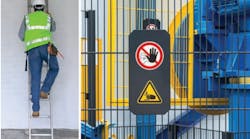The virus crisis adds a heavy burden to the already overwhelming list of field hazards linemen encounter daily. Since linemen are essential workers, they cannot stop working and stay home during the COVID-19 pandemic. Because the welfare of society rests on having uninterrupted access to reliable and safe electrical power, line crews must follow well-known precautions, both at work and at home. For example, they must maintain social distancing and wear their required face masks. Beyond following these guidelines to stop the spread of COVID-19, crews must also follow the requirements of the Occupational Safety and Health Administration (OSHA) on the job site.
Here are some of the top safety violations and how to avoid them.
Powered Industrial Trucks (PTI) and Ladder Safety
On a job site, linemen often work on or around heavy equipment and ladders. The failure to adhere to OSHA 29 CFR 1910.178, “Powered Industrial Trucks” was the No. 6 most-cited OSHA violation during fiscal years 2020, 2016 and 2015. PIT violations were the No. 7 most-cited during 2019, 2018 and 2017. Forklift operations following OSHA rules must address, at least:
• Operators’ certification requirements.
• Training, evaluations and a competency test at least once every three years.
• Removal from operations until repairs are made for any defective PTI.
The proper placement of ladders is important to prevent any movement that could result in a lineman’s fall.
Portable ladder placement must prevent any falls by:
•Setting it against the wall or vertical surface at a slope of 4 ft horizontally by each 1 ft of vertical rise (4H:1V).
• Securing it in place to prevent unexpected sliding/movement.
• Extending the top of the ladder by 3 ft above an upper landing surface.
• Using the ladder as designed and for the intended purposes.
• Removing from service and tagging accordingly any ladders with defects.
The failure to follow regulations found in OSHA 29 CFR 1926.1053, “Ladder Safety” was the No. 6 most-cited OSHA violation during fiscal years 2019, 2018 and 2017. Ladder safety violations were the No. 7 most-cited violation during 2020, 2016 and 2015.
Fall Protection Training, Electrical Wiring Methods and Machine Guarding
With linemen often working at an elevated height, another OSHA requirement — fall protection — is often an important way to stay safe on the job site. The OSHA requirements on fall protection training include, at least:
Availability of employer-sponsored programs to recognize hazards.
- Compliance programs verification by employers. OSHA 29 CFR 1926.503 covers all requirements for fall protection training. Failures to follow this OSHA’s rule resulted on the No. 8 most-cited safety violation during 2019, 2018 and 2017. In addition, OSHA 29 CFR 1910.305 addresses electrical wiring methods. During 2020 and 2015, failures to follow this safety classification became the No. 8 most-cited safety violation. Also, this was the No. 9 in 2016, and No. 10 in 2017. Another requirement on the job site is machine guarding, which must be done at all times to prevent any incidents. Guards and covers eliminate or control any potential hazards. Machine guards/covers (such as those on power saws, shears, guillotine cutters, connectors presses, etc.) prevent accidental slicing, crushing and tearing off of body parts. Types of guarding and exposure of blades are addressed by OSHA 1910.212. Failures to follow these requirements resulted in the No. 8 most-cited violation in 2016; and, the No. 9 most-cited safety violation during 2020, 2019, 2018, 2017 and 2015. Eye/Face Protection and Electrical General Requirements OSHA 1926.102 covers requirements for eye/face protection.
In addition to the required face/eye protection, linemen must make sure that the equipment being installed is inspected thoroughly before being energized. OSHA 1910.303 mandates that all electrical equipment be free from any recognized hazards to life and limbs. OSHA electrical general requirements ensure that:
- Labeling for identified purposes is in place.
- Required mechanical strength/durability of all parts, including those enclosing other parts, are designed and built as specified.
- Conductor insulation is adequate for the intended purposes.
- Interrupting rating, arc protection, and other electrical capability, as designed, are used.
- Markings as needed are adequate and eligible.
- Working spaces about/around floor-mounted or pole-mounted equipment are sufficient for workers to move while doing the work as required. Failure to follow this rule resulted in the No. 10 most-cited violation in 2020, 2016 and 2015.
Fuse cutouts, transformers and switches must be inspected before installation and energization are done. OSHA citations based on safety violations are serious. They indicate a lack of safety that could endanger the lives of employees and the public. And the citations are not only serious — they are expensive, too. The maximum cost per penalty in 2020 is $134,937 for a willful or repeated violation; $13,494 for a serious/other violation; and $13,494 per day beyond the abatement date. Of course, in addition to the high cost of penalties, the reputation of the company that committed the violations is greatly jeopardized. For contractors, that means the chances of winning future bids for new work are quite diminished. Following all COVID-19 safety practices, along with all safety rules and best practices, ensures that all linemen return home with the same 10 toes and 10 fingers that they came in with to work.


